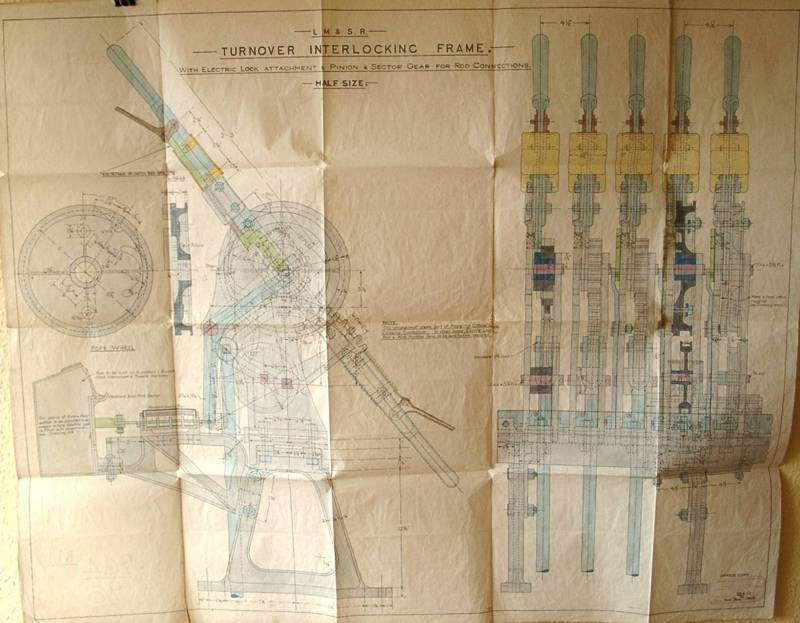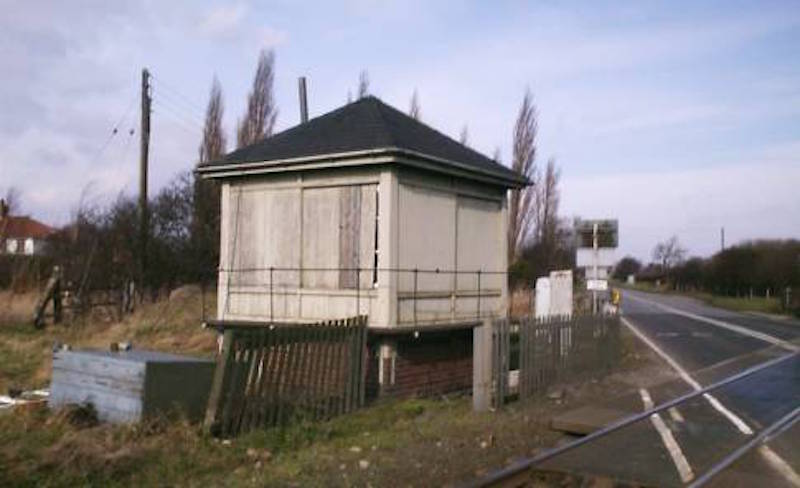Cottage Lane Crossing
Collingham, Nottinghamshire

Peter Churchman wrote:
Something which reared its head today - discussion about some long gone wire-worked points. The LMS tried a few installations of this type in 1929/30, on their loop-extension works on Mansfield - Southwell - Rolleston line, to allow the running of longer coal trains.
Three boxes affected/new under this scheme (viz. Mansfield Colliery Jct, Rufford Jct & Farnsfield) incorporated a few turnover levers in their frames, the rest being std REC tappet style. Other than this a few other installations appeared on ex Midland lines, - usually complete frames of the type (also known as "New Pattern Turnover" levers) - were installed in a few sidings boxes, probably at around the same time. Those that come to mind were:-
A few small frames were also tried at level xing frames (Eagle & Thorpe?) but uncertain of details. Apart from these few installations by LMS I know of only one other, this being GWR attempt at Johnston (S.Wales) where a few levers of similar (same?) type were inserted into what looks like a GW 5-bar VT frame. (Rly Gazette article refers).
.... and I felt obliged to jump in with this:
As you're probably aware, the non-interlocked turnover levers were common on the Midland Railway (and probably many others, as far as I know). The protoype, as far as the LMS was concerned, of an interlocked turnover lever frame, which was apparently of "a German design", was installed at Cottage Lane Crossing at Collingham near Newark on the Nottingham - Lincoln line. The new box was commissioned on 6th March 1927.
The original drawings for this frame still exist in a private collection (not mine, unfortunately, but I have a copy). Said drawing is dated 23rd November 1928. There seems, therefore, to be a discrepancy in dates, however, logic would suggest that the LMS would not put a new frame in an 18 month old wayside crossing box?

Meanwhile, the frame itself is preserved at the NRM and is on display in "The Warehouse".
In another place, here is what I have written about Cottage Lane:
Controlling the obliquely angled level crossing of the A1133 Newark to Gainsborough road, Cottage Lane Crossing at 21m 16c is just outside the village of Collingham. Like Colwick Crossing, the signal box here was unusual on the Nottingham - Lincoln line as it was provided purely as a Block Post. All other boxes were either at a station or controlled a yard or connection. Granted, it protected a level crossing – a busy one at that – but a crossing alone didn't necessitate a Block Post, as we've seen at Fiskerton, amongst others.
Dating from the introduction of Block working, the original structure was a small "hut" typically used by th eMidland Railway prior to the "Type 1" signal box. It was oriented so that the doorway opened onto the railway with a six lever non-interlocked turnover frame outside. This structure was replaced on 20th October 1895 and that one was in turn superseded on 6th March 1927.
The 1927 box was a Type 4d located on the Down side and despite being closed on 22nd November 1967 it still existed until February 2007. The diminutive 10’ square box has a chequered past. Despite its comparatively young age, it required extensive rebuilding in the 1950's to replace rotten timber. As a consequence it has a brick base and steps. Michael Vanns relates how the men carrying out this work contrived to get three corners of the box supported only on jacks while trains were still running by - much to the local inspector's alarm. While the steps were being replaced the signalman had to suffer the indignity of entering and exiting his box via the window to tend to his gates.
The frame fitted in this box, although not unique, was so unusual that it is now preserved in the National Railway Museum at York. It was a "LMS New Pattern Turnover" frame with seven levers. There were further examples of 'turnover levers' at the two Eagle crossings further along the line but this was different. Based on a German design, the upper part of the levers resemble normal signal levers with polished tops and rear catch-handle. Below this was a large cubic weight which gave the lever the momentum to rotate a circular pulley at its fulcrum by which the signal wire (no points here) was pulled.
The Auto Half Barriers were brought into use here on 1st November 1967 although the box didn't close immediately as it was customary to provide supervision for newly installed barriers to ensure they were operating correctly. Totally contrary to the normal course of events for a signal box closure in the late 1960's, the box wasn't demolished. It remained fully glazed and complete with its Eastern Region black on white enamel nameboard as late as 1972. Today the box is boarded up and painted grey. It is retained "for emergency use" which effectively means it is a shelter for a would-be crossing keeper working the barriers manually in times of failure.

Dave Harris, Willington, Derby, UK.
Email: dave@derby-signalling.org.uk
Page last updated: 18MAY2014